Tuesday, October 13, 2015
From Flagstaff, Arizona and the Grand Canyon we continued our trek east. Brooklyn and home were calling us. By the time we would arrive there it would have been a five week, two day trip during which time we would have driven almost 9,000 miles and passed through 21 states (some of them twice, coming and going).
It was time. And now It's also time to put this blog to sleep—a wonderful diary of our sojourn, complete with photos and descriptions of what we saw, where we went, who we met and more. We'll enjoy, I'm quite sure, looking back at this electronic journal some day, remembering our amazing journey and all that we saw.
So my final post covers the remainder of our trip from the Grand Canyon to Santa Fe and through the southwest. Then into Arkansas, Tennessee and up into Kentucky and Ohio (where we stopped for a second time at my sister's lake house) and from Ohio, our last long day back to Brooklyn. That's 2,500 miles—a lot to cover in one post. But here goes...
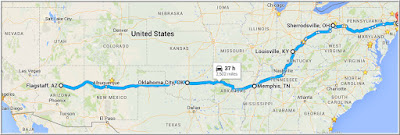 |
CLICK TO SEE THIS MAP LARGER.
Here's the last leg of our trip back east: From Flagstaff, Arizona (Grand Canyon) to Oklahoma City to
Louisville, Kentucky to Sherrodsville, Ohio and, finally, to home in Brooklyn, New York—that's
2,500 miles out of a total of 8,800 miles and 21 states. Whew! |
Before we got to Santa Fe and New Mexico, and a bit east of the Grand Canyon and while cruising along on Interstate 40, we saw an exit sign: Winslow. Hmm—why did that name sound so familiar? Oh yes! The Eagles song had impressed the name of this obscure town on millions of our generation's memories:
Take It Easy, written by Jackson Browne and performed by both him and the Eagles. Of course we got off the highway and discovered that everyone over the age of sixty does the same thing as this one-road town's claim to fame is that immortal song. The town Mothers and Fathers have erected a wall (no building behind it; just a wall, painted a sweet mural on it and called that corner
Standing On The Corner park.
 |
And yes, it's on the old and famous Route 66. "Standing on a corner in Winslow, Arizona, what a pretty sight
to see...." |
 |
There's a woman, a dog and Jackson Browne with his guitar.
In the back on the wall—a girl, my lord, in a flatbed Ford.…
|
Listen to Jackson Browne sing Take It Easy.
After a while we entered New Mexico, drove through Albuquerque and ended the day's travel in Santa Fe. We'd spend a few hours the next day, exploring the town square and its historic buildings. Santa Fe is the oldest capital city in North America and its Palace Of The Governors, a beautiful old adobe edifice, now the state's history museum, is said to be the oldest continuosly-used public building in the country. Under its porticos, Native American crafts artisans were selling their wares to the tourists who are the town's economic mainstay
We promised ourselves a return trip to Santa Fe to give the town its due. With its beautiful architecture, rich history and artsy vibe, we wanted more but, again, home was calling.
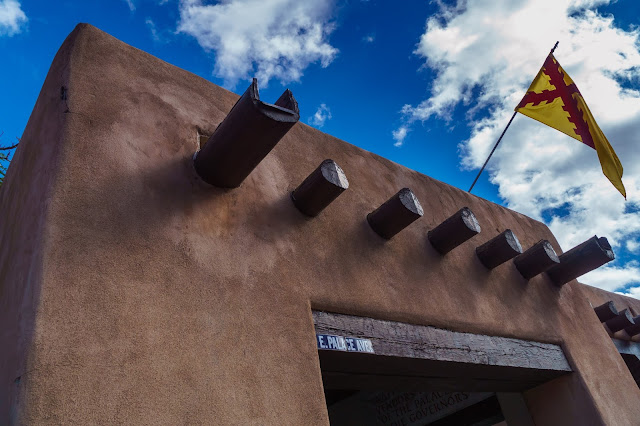 |
| Bright blue skies and adobe construction: Santa Fe! |
 |
| The Palace Of The Governors is the oldest continuously-used public building in the United States. |
 |
Adobe style buildings are the required mode
if building in Santa Fe's historic district.
We loved their simple beauty and color. |
 |
| Gorgeous adobe house on a back street off the main square in Santa Fe. |
 |
| New Mexico. Yes! |
We left Santa Fe and we pointed our chariot eastward again.On our way, we'd cross the Texas panhandle, driving through Amarillo and its cattle stockyards which were adjacent to I-40. If you ever want to find out what the word "stench" actually means, take that ride . For miles before and after the yards, a horrible smell of urine, ammonia and dung permeated the air, making its way into the car. Enough to make one a vegetarian—I thought about the poor animals on their way to slaughter who had to inhale this noxious gas that surrounded them.
 |
We crossed a snip of Texas and passed by stockyards near Amarillo.
The stench permeated the air for miles before and after. |
 |
Little Biggie is dreaming of Brooklyn as we drive eastward.
He's sitting on my lap, basking in the sun as Stacey drives. |
 |
Well, well, well, eco-friendly wind turbines in the Oil State of Texas. A lovely sight to behold: thousands
of them generating power without the slightest trace of carbon dioxide exhaled into our atmosphere. |
Hey Lyle—where you from?
It would be a 14-hour slog to Memphis,Tennessee so we decided to cut that segment in half, stopping in Oklahoma City, about eight hours away and then on to Memphis the next day. Oklahoma was a long slog but it too had something interesting to offer us: Okemah! When I saw the exit sign on I-40, again it called out to me. We recently celebrated the 100th birthday of America's great poet and songwriter—Woody Guthrie and this was his birthplace. Off we got again, to explore his home town and the park that was created in his memory. Another worthwhile detour.
While you're reading, listen to Woody sing
about the beauty of our country—but also its contradiction—
beauty and rewards denied to the women and men
who work in its Pastures Of Plenty.
Woody—so ahead of his time!
 |
| Welcome to Okemah, Oklahoma—Home of Woody Guthrie. |
 |
| Hmmm...What would Woody do? |
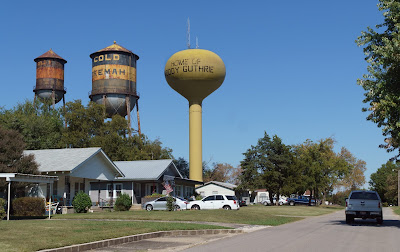 |
| Even the town's water tower remembers Woody's name. |
 |
| A lovely mural in the park. |
 |
Memorial stones dedicated by so many supporters—each with one of Woddy's
great ballads inscribed on it. |
 |
| The park's memorial plaque. |
 |
| More memorial stones. |
 |
Here's the Seeger family's stone—beautiful. I didn't know that song, "Cleano"—but now I do.
It's one of Woody's innumerable songs written for children and it's wonderful! |
And here's a rendition of this sweet kid's song
whose title is enscribed on the Seeger stone.
Listen to Cleano.
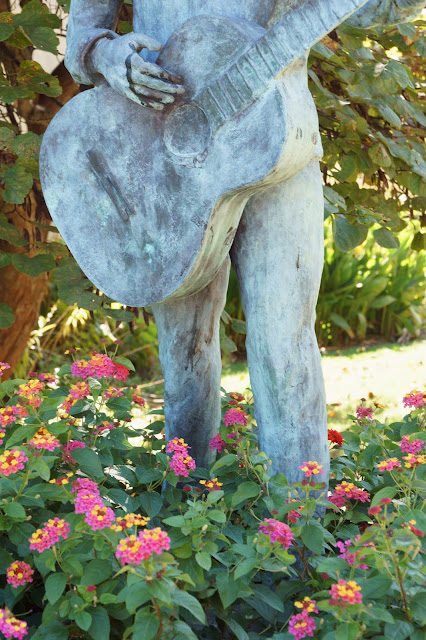 |
| A beautiful statue of the bard graces this sweet little park. |
 |
| Hello Woody—it's been good to know ya! |
 |
| A view of the park and a great mural. |
 |
The town of Okemah. Main Street—like so many American towns that the
interstates and malls have resulted in loss of vitality and life. |
 |
I was amazed at the number of movie theaters in these western cities and towns, many of which have been
restored and are still in use—some small like this one, some grand and magnificent in their design and stature. |
 |
| Little Biggie wants to put his imprint in cement in front of Okeman's Crystal Theater. |
We'd been Memphis many years earlier, when our son was in school in Nashville. Our motel was in West Memphis, Arkansas on the west side of the Mississippi. But for dinner we took a short drive into Memphis proper for a wonderful barbecue dinner at a place called
Vergos Rendezvous.
 |
| Great (really great) barbecue at Vergos Rendezvous in Memphis. |
 |
| A pitcher of draught, barbecue and a beautiful woman—at Chrales Vergos Rendezvous restaurant in Memphis. |
 |
This is the place—not easy to find as it's down a little alley not out
on the street as its address indicated. |
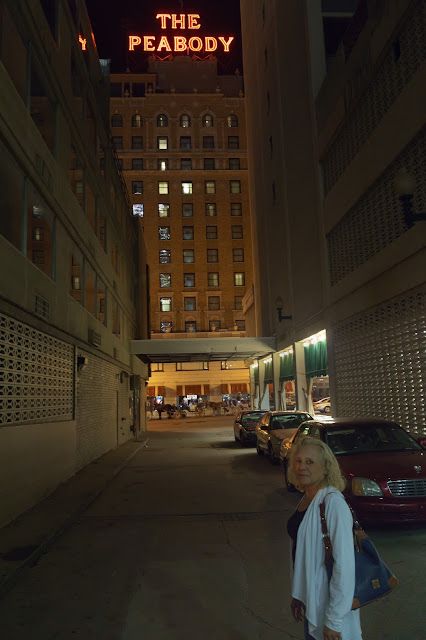 |
The restaurant was down this alley from Memphis' iconic old hotel: The Peabody.
We had trouble finding it—until we asked a resident. |
The next stop after Memphis was Louisville—not much to write about here as it was just an overnight rest stop to the east of the city. Again we traveled on, now northbound for a while as we headed up to my sister's place in Ohio. But we did want to make a brief stop in Cincinatti. It was here, a few years ago on a separate road trip with my friend, Lonnie, that I discovered some of the charms of this somewhat Southern city—specifically a miniature Brooklyn Bridge, designed and built by the man who designed the genuine article. The John A. Roebling bridge, as it's called, connects Cincinatti, Ohio and Covington, Kentucky. It spans the Ohio River and Roebling practiced his craft by constructing this bridge and others, a few years before he and his son built their masterpiece over New York's East River.
 |
The John A. Roebling bridge, as seen from Covington, Kentucky. Cincinatti is visible across the Ohio.
Does this bridge remind you of another, more famous one—let's say in Brooklyn? |
 |
Originally called the Cincinnati-Covington bridge, it was renamed in honor
of its designer, John Roebling, who went on to build his masterpiece—the
Brooklyn Bridge. |
 |
We're gonna walk across this bridge from Kentucky to Ohio. But half way there we turned back—it was a
tad scary, looking down into the murky Ohio far below. |
 |
Cincinattians and Covingtonians regularly walk back and forth to enjoy lunch on the other side
or just a nice stroll with great views. |
Let me take a moment again to give praise to Google Maps and navigation. As we approached Cincinatti on I-75, Google made an announcement:
"There's a one-and-a-half hour delay on I-75. Would you like a shorter route?"
Duh! I hit "accept" and the app routed me around the trouble and back on. Voilá! We would have sat in stand-still traffic not having that friendly suggestion.
We were now within striking distance of my sister, Duba's, lake house in eastern Ohio. We passed through Columbus and an hour or so later we arrived. Stacey and Duba prepared a great dinner. Biggie romped on her back lawn that spralls down to Atwood Lake—a conservation lake which, at this time of year was surrounded by beautiful foliage and was devoid of people and boats. An added bonus was the presence of my brother-in-law, Buddy. It was the fitting way to close out our cross country road trip.
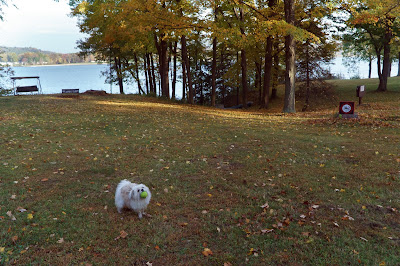 |
Biggie in Ohio at Duba's: so glad to be out of the back seat
on her big expanse of lawn that looks out over beautiful Atwood Lake. |
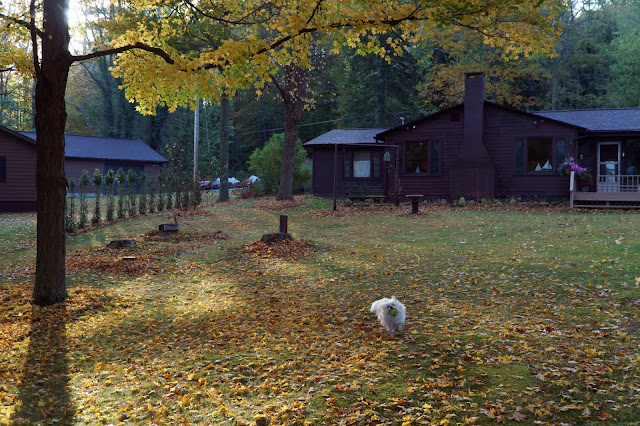 |
| Foliage and leaves in eastern Ohio. |
 |
The sun was rising and we'd be heading for Brooklyn soon.
Can you wait to see your old house Biggie? |
 |
| My sister's beautiful lake house in Sherrodsville, Ohio. |
 |
Biggie came along with us—9,000 miles—this is a great little
dog and a wonderful travel companion! |
 |
| Buddy and Duba. Great hosts! |
 |
| My bro-in-law and sister, Buddy and Duba. |
 |
| Four beings—a dog and three people. |
 |
| Me (Matt), Buddy and Duba. |
 |
| My sweet sis. |
The next day we left early, taking the Pennsylvania Turnpike after crossing a bit of West Virginia and passing by Duba and Buddy's home base of Pittsburgh. When we pulled up in front of our Brooklyn brownstone—well it was a sight for sore eyes. Biggie went beserk. I imagine he had either forgotten about it (not likely) or was so very happy, nay ecstatic, to be home again and not cooped up, day after day, in the back seat of a Subaru.
You know what? We agreed with him. I hope you enjoyed this narrative. Perhaps it gives you some ideas on a trip that you might take some day. Perhaps you just enjoyed coming along with . In either case, hope to see you on the road!
A bientot!
—Matt (and Stacey and Biggie...from Brooklyn)
 |
| Home Sweet Home—9,000 miles and five weeks later! |






























































